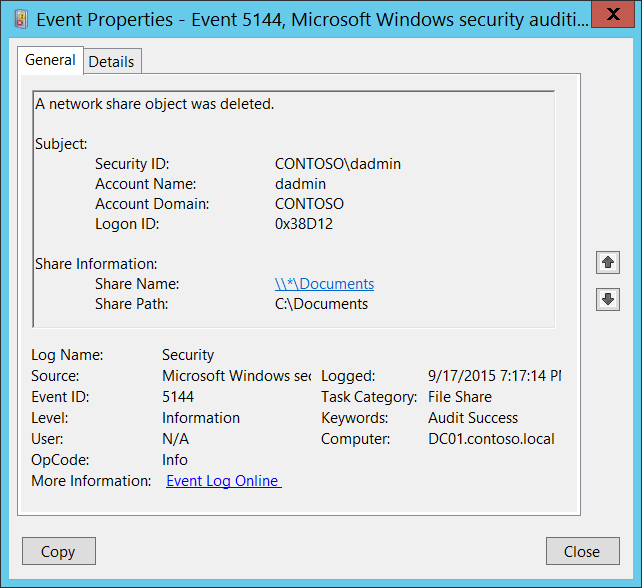5144(S): A network share object was deleted.

Subcategory: Audit File Share
Event Description:
This event generates every time a network share object is deleted.
Note For recommendations, see Security Monitoring Recommendations for this event.
Event XML:
- <Event xmlns="http://schemas.microsoft.com/win/2004/08/events/event">
- <System>
<Provider Name="Microsoft-Windows-Security-Auditing" Guid="{54849625-5478-4994-A5BA-3E3B0328C30D}" />
<EventID>5144</EventID>
<Version>0</Version>
<Level>0</Level>
<Task>12808</Task>
<Opcode>0</Opcode>
<Keywords>0x8020000000000000</Keywords>
<TimeCreated SystemTime="2015-09-18T02:17:14.820551800Z" />
<EventRecordID>268368</EventRecordID>
<Correlation />
<Execution ProcessID="4" ThreadID="4656" />
<Channel>Security</Channel>
<Computer>DC01.contoso.local</Computer>
<Security />
</System>
- <EventData>
<Data Name="SubjectUserSid">S-1-5-21-3457937927-2839227994-823803824-1104</Data>
<Data Name="SubjectUserName">dadmin</Data>
<Data Name="SubjectDomainName">CONTOSO</Data>
<Data Name="SubjectLogonId">0x38d12</Data>
<Data Name="ShareName">\\\\\*\\Documents</Data>
<Data Name="ShareLocalPath">C:\\Documents</Data>
</EventData>
</Event>
Required Server Roles: None.
Minimum OS Version: Windows Server 2008 R2, Windows 7.
Event Versions: 0.
Field Descriptions:
Subject:
- Security ID [Type = SID]: SID of account that requested the “delete network share object” operation. Event Viewer automatically tries to resolve SIDs and show the account name. If the SID cannot be resolved, you will see the source data in the event.
Note A security identifier (SID) is a unique value of variable length used to identify a trustee (security principal). Each account has a unique SID that is issued by an authority, such as an Active Directory domain controller, and stored in a security database. Each time a user logs on, the system retrieves the SID for that user from the database and places it in the access token for that user. The system uses the SID in the access token to identify the user in all subsequent interactions with Windows security. When a SID has been used as the unique identifier for a user or group, it cannot ever be used again to identify another user or group. For more information about SIDs, see Security identifiers.
Account Name [Type = UnicodeString]: the name of the account that requested the “delete network share object” operation.
Account Domain [Type = UnicodeString]: subject’s domain or computer name. Formats vary, and include the following:
Domain NETBIOS name example: CONTOSO
Lowercase full domain name: contoso.local
Uppercase full domain name: CONTOSO.LOCAL
For some well-known security principals, such as LOCAL SERVICE or ANONYMOUS LOGON, the value of this field is “NT AUTHORITY”.
For local user accounts, this field will contain the name of the computer or device that this account belongs to, for example: “Win81”.
Logon ID [Type = HexInt64]: hexadecimal value that can help you correlate this event with recent events that might contain the same Logon ID, for example, “4624: An account was successfully logged on.”
Share Information:
Share Name [Type = UnicodeString]: the name of the deleted share object. The format is: \\*\SHARE_NAME
Share Path [Type = UnicodeString]: the full system (NTFS) path for the deleted share object. The format is: \\??\PATH.
Security Monitoring Recommendations
For 5144(S): A network share object was deleted.
Important For this event, also see Appendix A: Security monitoring recommendations for many audit events.
If you have critical network shares for which you need to monitor all changes (especially, the deletion of that share), monitor for specific “Share Information\Share Name”.
If you have high-value computers for which you need to monitor all changes (especially, deletion of file shares), monitor for all 5144 events on these computers. For example, you could monitor file shares on domain controllers.